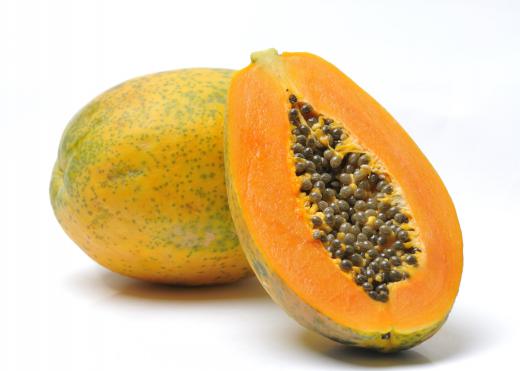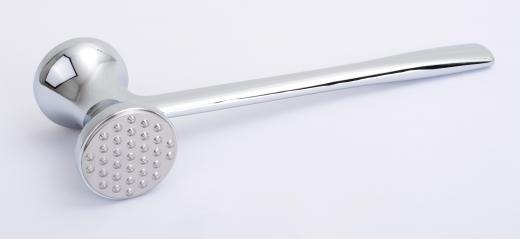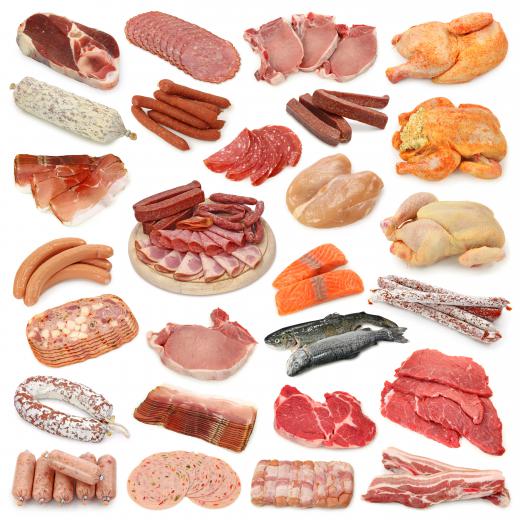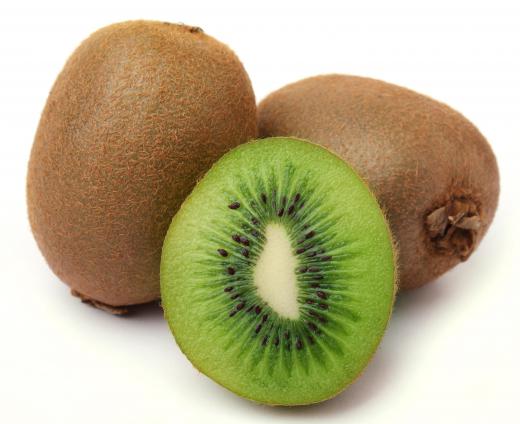How do Meat Tenderizers Work?
 Michael Anissimov
Michael Anissimov
The way a meat tenderizer works depends on whether it is an enzymatic tenderizer or a manual tool. The first type breaks down the bonds between the cells of a piece of meat on a chemical level, while the second breaks the bonds using force. There are also several other substances that can be used to make meat softer, including beer, ginger, and vinegar, which work by breaking down cellular bonds. Though any type of meat can be made softer, tougher cuts like brisket, lamb breast, and chuck steak tend to do best, since they have the most connections to break down.
Enzymes

Enzymatic meat tenderizers are made of proteolytic enzymes called proteases, which break down the peptide bonds between the amino acids found in complex proteins. This makes the meat softer, since one of the main things holding meat together is the complex protein collagen. The most common types of enzymatic tenderizers are bromelain, which is made from pineapples; papain, which is made from papayas; actinidin, which is made from kiwis; and ficin, which is made from figs. When sprinkled on uncooked meat, they can soften it within minutes, but may make it squishy if left on too long. They can be used both in marinades or independently.
Mechanical Tools

There are also mechanical meat tenderizers that look like mallets or hammers with a rough, spiky surface that is brought down onto the meat. When the spikes hit the meat, the force breaks the muscle fibers and collagen bonds apart, making it softer. Depending on the thickness of the meat and the toughness of the cut, a person may have to hit it for several minutes to make it soft enough. These tools can also be used to flatten meat for making schnitzel, minute steak, or other dishes that need very thin or uniform pieces of meat.
Alternative Tenderizers

Other products can be used to improve the texture of meat, even if they're not usually sold as meat tenderizers. This includes mostly acidic produce, like ginger and tomatoes, as well as acidic beverages like coffee, beer, and soda. These also work by breaking down the bonds that hold meat cells together, but they do it with acid, rather than enzymes. Baking soda and fermented milk products like yogurt can also soften meat enzymatically, as can using the fruits that many meat tenderizers are made from — pineapples, papaya, kiwi, and figs.
Precautions

Though most meat tenderizers are effective, it's important to use them properly to get the desired effect. Acidic and enzymatic substances should not be used with metal cookware, since it can react and affect the flavor or color of the meat. Also, enzymatic tenderizers have a temperature at which they become inactive, but if this isn't reached during cooking, they'll continue to work. Papain, for example, won't be inactivated by cooking a steak to medium-rare, and will continue to soften any leftovers, making them mushy.
Pros and Cons of Tenderizing

Tenderizing meat can make it softer and improve its texture. It also makes it easier to cut and can often cut cooking time. Additionally, it may be necessary for some recipes that call for meat to be all one thickness, and can ensure that meat cooks evenly. Despite this, using tenderizers for too long or on meat that's already soft can make it unpleasantly squishy, and it may be difficult to anticipate how different ingredients in a recipe interact with enzymatic or acidic tenderizers. To get good results with this process, it's generally best to understand the recommended time for using each substance, consider any reactions it might have with oils or cookware, and to choose cuts of meat that contain a lot of collagen, like the shank, brisket, neck, or ribs.
AS FEATURED ON:
AS FEATURED ON:


















Discussion Comments
Is it safe to use meat tenderizer overnight? I put it on meat but decided to cook something else and I left it overnight. Is it okay if I use the meat or is it dangerous?
Help! I put too much meat tenderizer powder onto my meat! I didn't realize it was a tenderizer and put the whole packet into 1kg of meat. It completely changed the color of the meat! Is too much poisonous?
Why do meat tenderizers lose potency with time?
Actually, we had this activity just recently and I was amazed by the reactions of enzymes!
its been helpful but i need more on the hydrolysis and amide bonds for my explanation.
thanks. this has been a huge help with my cooking assignment.
Very nice!
For anon13417, enzymes are found in pineapples that break down proteins. Bromelain, often the key ingredient in most meat tenderizers, is from the juice and stems of pineapples.
Why do cooks usually place pineapples on meat before cooking it? What is the whole process from the enzyme proteolytic bromelain do to the entire meat like denaturing proteins and everything in detail. thanks and i hope to be able to get an answer!
I enjoyed this article. I will use it with my High School Anatomy students when we study digestion and when we study DNA. We'll use the protease to break down the proteins that bind DNA.
good fun! Thanks!
What role does vinegar play in tenderizing meat?
Post your comments